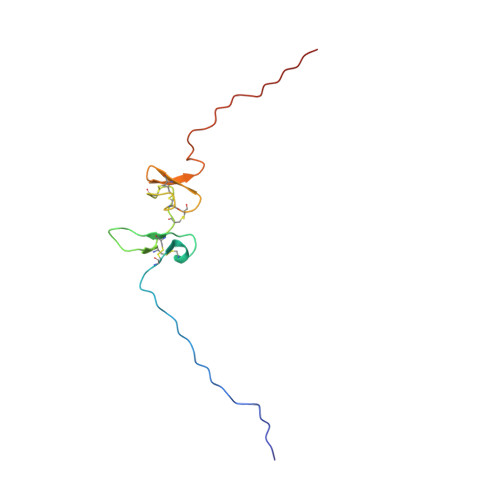Structural and functional analysis of Dickkopf 4 (Dkk4): New insights into Dkk evolution and regulation of Wnt signaling by Dkk and Kremen proteins.
Patel, S., Barkell, A.M., Gupta, D., Strong, S.L., Bruton, S., Muskett, F.W., Addis, P.W., Renshaw, P.S., Slocombe, P.M., Doyle, C., Clargo, A., Taylor, R.J., Prosser, C.E., Henry, A.J., Robinson, M.K., Waters, L.C., Holdsworth, G., Carr, M.D.(2018) J Biol Chem 293: 12149-12166
- PubMed: 29925589
- DOI: https://doi.org/10.1074/jbc.RA118.002918
- Primary Citation of Related Structures:
5O57 - PubMed Abstract:
Dickkopf (Dkk) family proteins are important regulators of Wnt signaling pathways, which play key roles in many essential biological processes. Here, we report the first detailed structural and dynamics study of a full-length mature Dkk protein (Dkk4, residues 19-224), including determination of the first atomic-resolution structure for the N-terminal cysteine-rich domain (CRD1) conserved among Dkk proteins. We discovered that CRD1 has significant structural homology to the Dkk C-terminal cysteine-rich domain (CRD2), pointing to multiple gene duplication events during Dkk family evolution. We also show that Dkk4 consists of two independent folded domains (CRD1 and CRD2) joined by a highly flexible, nonstructured linker. Similarly, the N-terminal region preceding CRD1 and containing a highly conserved N X I(R/K) sequence motif was shown to be dynamic and highly flexible. We demonstrate that Dkk4 CRD2 mediates high-affinity binding to both the E1E2 region of low-density lipoprotein receptor-related protein 6 (LRP6 E1E2) and the Kremen1 (Krm1) extracellular domain. In contrast, the N-terminal region alone bound with only moderate affinity to LRP6 E1E2, consistent with binding via the conserved N X I(R/K) motif, but did not interact with Krm proteins. We also confirmed that Dkk and Krm family proteins function synergistically to inhibit Wnt signaling. Insights provided by our integrated structural, dynamics, interaction, and functional studies have allowed us to refine the model of synergistic regulation of Wnt signaling by Dkk proteins. Our results indicate the potential for the formation of a diverse range of ternary complexes comprising Dkk, Krm, and LRP5/6 proteins, allowing fine-tuning of Wnt-dependent signaling.
Organizational Affiliation:
Leicester Institute of Structural and Chemical Biology, Lancaster Road, Leicester LE1 7HB, United Kingdom; Department of Molecular and Cell Biology, University of Leicester, Lancaster Road, Leicester LE1 7HB, United Kingdom.














